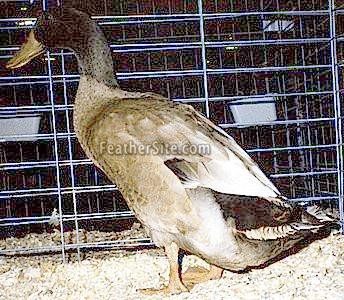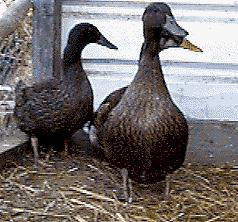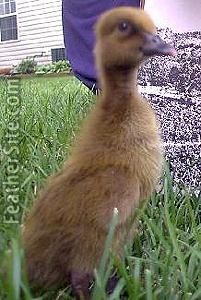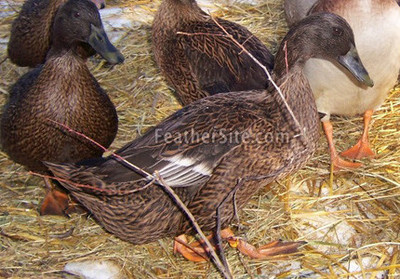
Old Khaki Campbell drake

Khacampbell females
The Khaki Campbell was developed in England during the early 1900's by Mrs/ Adele Campbell of Uley , Gloucestershire who wanted a breed for laying white table eggs that was not broody , reluctant to fly off and reacted nearer to a fowl . It was admitted to the American Standard in 1941. Though originally a cross of Indian Runner, Mallard, and Rouen, Campbells exceed all of these and most chicken breeds in egg production, with some strains averaging 300 eggs per year. They do not require special care or artificial lighting to produce a large number of eggs, which are white and weight about 2.5 ounces (not much larger than a Leghorn egg). Thought not usually raised for meat, Khakis make high quality, lean roasters of 3-4 pounds; they average 4-5 pounds as adults. Campbells are extremely hardy, are excellent foragers, and are at home on land as well as in water. They eat large quantities of slugs, snails, insects, algae, and mosquitos from ponds, but do not require swimming water to stay healthy. The ducks are mainly khaki colored and the drakes have greenish-bronze heads with brown-bronze tails, backs, and necks. They have green bills
Status: Minor. Though still not common, the Khaki Campbell is thought to be growing in popularity as an egg-layer and backyard duck. Exhibition Khakis do not have the same characteristics as production types

HISTORY
Campbell's have a well known history Campbell It was bred from Mallard ;Fawn and White Runners and Rouen with a very vague standard in order to keep the utility properties of the breed. From these a white sport was standardized as the White Campbell and a Dark Campbell was created by a Mr H R S Humphreys in Devon to enable a classic gold / silver cross mating for sex linkeage. This colouration did not find favour after the second world war and declined to almost critical levels and although the white and the khaki are often seen very few breeders keep the dark Campbell and due to the small gene pool a number throw eye stripes which are incorrect for the breed and a throwback as are any of the colours that lay blue or green eggs ... these birds should not really be bred from as not up to the breed standard
Broodiness: pretty useless most will sit long enough for you to put fertile eggs under her then walk away. Bred to be a non sitter but as many are crossed unless bought from a good breeder some will sit but are rare
Needs: Do not require water for swimming to stay health, but they enjoy it. Prefer shallow trays or even a washing up bowl with a brick in it . . no brick produces a tortoise with webbed feet hybrid very funny but also Very messy
Notes:Excellent foragers, keeping gardens and ponds free of, slugs, snails and worms; bred as a back garden duck two females are very happy with chickens or on their own and will give a dozen eggs per week if fed well.


A first-year Khaki Campbell duck
A Khaki Campbell duckling
Dark Campbell Ducks
Dark Campbell females
Appearance: Drakes, Beetle green head & neck, Shoulder breast light brown each feather finely pencilled with dark grey brown shading to silver grey nearer the vent - Bill blue/grey/green with a black bean. Legs and feet orange
Ducks, Dark brown version of the khaki with similar lacing. Feet and webs dark brown colour with slate bill Size: Drakes, 2.5 to 3 kg Ducks, 2 to 2.5 kg
Dark Campbell Defects; Yellow Bill; Any white in neck or bib; Same feather colour under wing (caused if crossed with Khaki); Lack of feather lacing in ducks ie uniform smooth khaki feathers like the drake (caused if crossed with Orpingtons !) Lack of fine lacing in males. Blue eggs
******genetically a dusky format of the khaki . Blue so far partially unstable format is produced bt Dark males to khaki females******
White Campbell Ducks
Appearance: Drakes, Orange/Yellow bill, and webs; white neck, back and tails -
Ducks, White with Orange/ yellow bill and webs Size: Drakes, 2.5 to 3 kg Ducks, 2 to 2.5 kg
White Campbell Defects; Flesh coloured Bill; Eye stripes in young birds as they feather... covered once they get their adult plumage. Brown eyes. Blue eggs
KHAKI CAMPBELL Ducks
Appearance: Drakes, Green bill, greenish bronze head, brown-bronze neck, back and tails -
Ducks, Khaki colour with green bill Size: Drakes, 2.5 to 3 kg Ducks, 2 to 2.5 kg
Khaki Campbell Defects; Yellow Bill; Pinkish Bill. Any white in neck or bib; White or light under wing (caused if crossed with Darks); Lack of feather lacing in ducks ie uniform smooth khaki feathers like the drake (caused if crossed with Orpingtons !). Blue eggs
Names:-Le canard Kaki Campbell, .original ?
Country Of Origin;......... Great Britain. An early 20th Century Breed
Carriage; Angled carriage laced feathering
Purpose;... .......Eggs..meat(males)
Egg Colour .....300-350 white eggs/year weighing approx., 71-75 gms each
Breed Defects. .. . . .Blue eggs or as below
Breed info . . . . designed to be with chickens a splasher rather than a swimmer
Breed Hints....Kept as trio or more. will go not broody and hatch as a rule ** unsuitable as a pair in Khaki due to the energy of the drakes **
Weights; 4 to 6 pounds . . .Meat Production: High quality very lean meat approx. 1.25 to 2.25 kg drakes at 16/18 weeks
Breed Tip Incubation: 28 days Maturity: ie rubbish broodies and mothers, normally sit for 65% of time needed or lose any resulting babies
Flying . rarely flies a good back garden all rounder

Genetic profile Khaki
Gene :Dusky / symbol md / Recessive
Allelic to mallard and restricted and recessive to both. The dusky pattern is darker and plainer than the mallard both in the day-old and adult. Breed examples are Khaki Campbell and Buff Orpington

Genetic profile White
Gene :Recessive white/ symbol c/ Recessive
This gene is responsible for the white in common white breeds. In the homozygous state, recessive white masks all other color genes . as in the White Campbell
Genetic profile Dark
Gene Dark Dusky Phase/ symbol Li+ /Dominant..
This gene is the wild-type gene present in the mallard and the Rouen breed. It allows full expression of the three alleles of the M+ locus.They do not have a brown gene but are a darker version of the Khaki as in :-Allelic to mallard and restricted and recessive to both. The dusky pattern is darker and plainer than the mallard both in the day-old and adult






ساحة النقاش